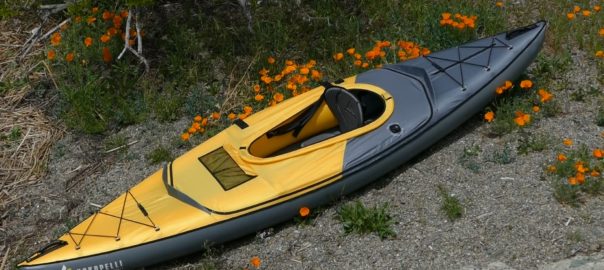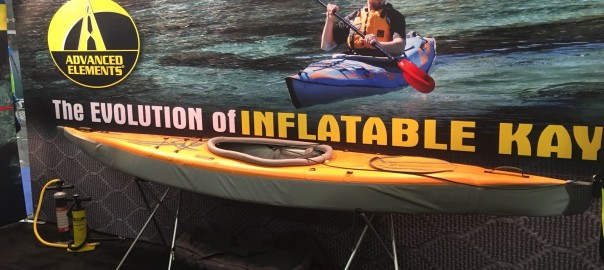We recently posted our Sneak Preview on the new series of Moki inflatable kayaks from Kokopelli Packraft – two exciting new models we’ve seen for 2020. What’s so special? The new Moki Series expands the Kokopelli product line, providing a traditional paddling experience.
Last month, the 2020 models started rolling in. We began the series with the new 13.6 lbs XPD, so we now turn to the high-pressure Moki inflatable kayak, a 12 ft 2-inch model with zip-off deck and spray skirt.
Getting Started with the Kokopelli Moki Inflatable Kayak
We unpacked the box and laid out the pieces – inflatable kayak body with high pressure floor, EVA seat, removable deck, spray skirt, foot brace, coaming tube, pump with gauge, repair kit, roller backpack, fin, deck rod, repair kit and instructions. The fin and the repair kit are found in a pocket inside the backpack.
Boxed up, the dimensions are 36 x 25 x 15 inches with a shipping weight of 58 lbs. The kayak weighs 33 lbs with the seat, floor, brace and fin – add another 1.75 lbs for the deck and 1 lb for the coaming and spray skirt. All packed up in the bag, everything weighs 46 lbs. The folded kayak size is 29 x 21 x 9 inches.
The generic instructions for Kokopelli’s inflatable kayak series include inflation and deflation techniques, deck, seat and skirt installation, but lack details on actual set up; we will outline the steps we took, below. In general, set up is straight-forward – unpack, unfold, inflate.
The first step is to unfold the kayak.
The Kokopelli Moki utilizes three main GRI push-push valves for inflation. These are very simple to use and feature an inflate mode (spring plunger is UP) and a deflate mode (spring plunger is DOWN). By using your finger to gently push on the plunger, it can be moved to the inflate mode (air goes in and doesn’t come back out) and deflate mode (air goes in and comes back out). Before you go to all the effort of inflating the board, PLEASE make sure the plunger is in the inflate position.
Next, set up the pump – this is not mentioned in the instructions. The Moki comes with a very nifty, collapsible, dual-action Nano pump and built-in pressure gauge. Fold down the feet and attach the hose to the side that says Inflate (there is also a Deflate side). There are two pieces of plastic tubes in the plastic packaging – these are screw on handles. Unfortunately, there is no place to attach/store the handles when removed so you may want to buy a mesh laundry bag to keep everything together. Or, don’t even bother attaching the handles as the pump is pretty easy



You must be logged in to post a comment.